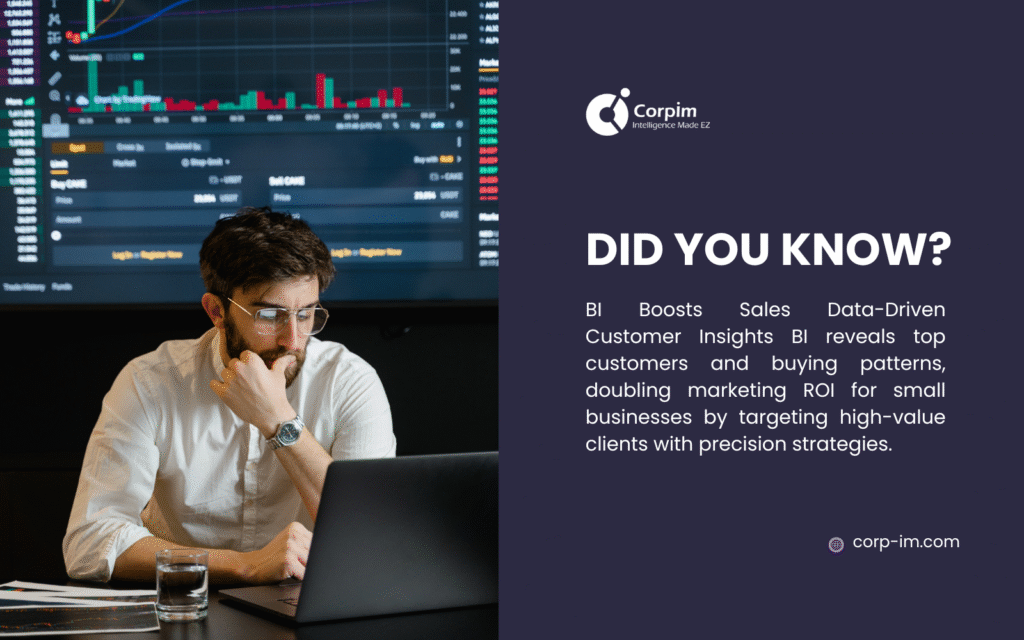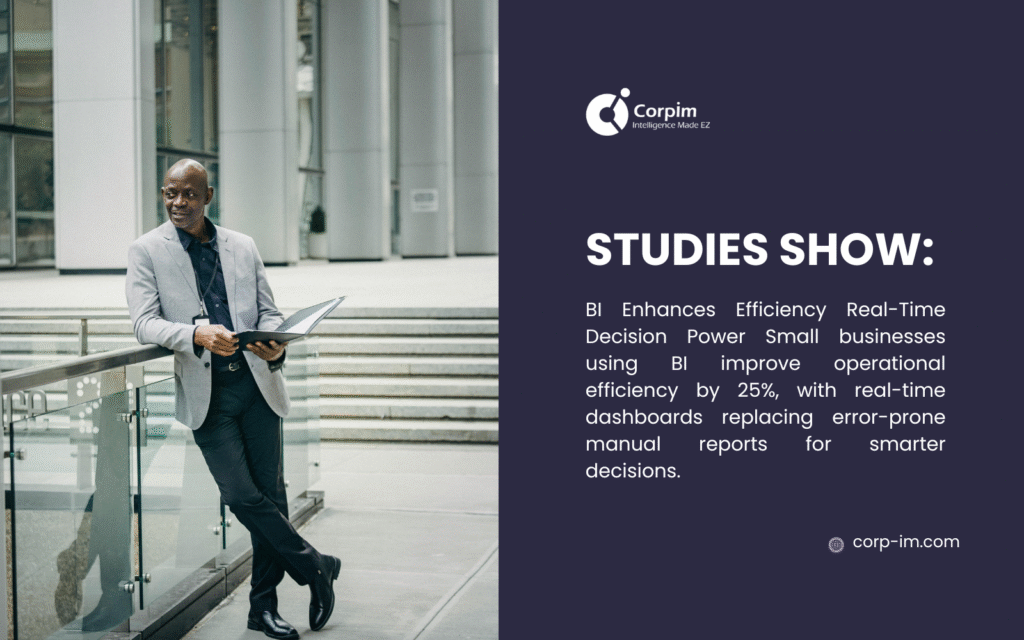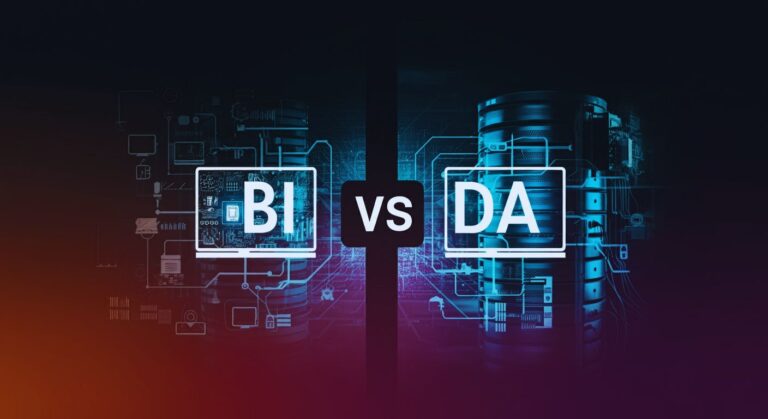Article Summary
This comprehensive guide explores how small businesses can leverage business intelligence to drive growth and compete effectively. Key topics covered include:
- Core benefits of business intelligence implementation for small enterprises
- Cost-effective BI solutions tailored for limited budgets
- Real-world applications across different business functions
- Implementation strategies that minimize disruption
- ROI metrics and performance indicators
- Technology considerations for small business environments
- Future trends in AI-powered business intelligence
Most small businesses struggle with scattered data across multiple systems. Sales numbers sit in one application, customer information in another, and inventory data somewhere else entirely. The benefits of business intelligence for small businesses solve this exact problem by pulling all data into one central location where it actually makes sense.

Why Small Businesses Need Business Intelligence Now
Small business owners make hundreds of decisions weekly. Which products sell best? What customers buy most frequently? How much inventory should you order next month? Most owners answer these questions with gut feelings because they lack proper data analysis tools.
Business intelligence changes this completely. Instead of guessing, you get clear answers based on real numbers. Your sales data shows exactly which products generate the most profit. Customer analysis reveals who spends the most money and comes back regularly. Inventory reports tell you what to stock and when.
The old way meant pulling reports from different systems, then manually combining them in spreadsheets. This process took hours and often contained errors. Modern BI platforms connect directly to your existing systems and create reports automatically.
| Traditional Method | Business Intelligence Method | Time Difference |
| Pull data from 5 different systems | Automated data collection | 4 hours vs 5 minutes |
| Manual spreadsheet compilation | Automated report generation | 2 hours vs instant |
| Monthly reporting only | Real-time dashboards | 30 days vs live updates |
| Error-prone manual calculations | Automated accuracy | High errors vs zero errors |
| Limited historical analysis | Complete historical trends | Basic vs comprehensive |
Cost Savings That Actually Matter
Business Intelligence vs Data Analytics might sound like expensive enterprise software, but modern solutions cost less than most businesses spend on coffee each month. The savings come from three main areas.
First, you stop wasting money on inventory that doesn’t sell. BI shows exactly which products move fast and which collect dust. One retail client reduced inventory costs by 22% in six months simply by ordering based on actual sales data instead of assumptions.
Second, you identify customers who buy frequently versus those who purchase once and disappear. Marketing dollars go toward proven buyers instead of random prospects. This targeted approach typically doubles marketing ROI within the first year.
Third, operational efficiency improves dramatically. Staff time previously spent gathering data now goes toward actual business activities. Business intelligence reporting handles the number crunching automatically.
| Cost Category | Before BI | After BI | Annual Savings |
| Excess Inventory | $50,000 | $30,000 | $20,000 |
| Wasted Marketing | $15,000 | $7,500 | $7,500 |
| Staff Time on Reports | $25,000 | $5,000 | $20,000 |
| Poor Pricing Decisions | $12,000 | $2,000 | $10,000 |
| Total Annual Savings | – | – | $57,500 |
Real-World Applications for Small Businesses
Retail Store Operations
Small retailers use BI to track which products sell during specific seasons, times of day, or weather conditions. One clothing store discovered that rainy days increased jacket sales by 40%, leading to better inventory planning and weather-based promotions.
Stock management becomes precise rather than guesswork. The system alerts when popular items run low and suggests reorder quantities based on historical sales patterns. This prevents both stockouts and overstock situations.
Customer behavior analysis reveals shopping patterns. Some customers buy regularly but spend small amounts. Others shop infrequently but make large purchases. BI identifies these segments so you can create appropriate marketing strategies for each group.
Service-Based Businesses
Service companies use BI to optimize scheduling and resource allocation. A landscaping company discovered that certain neighborhoods generated 60% more revenue per hour than others, leading to strategic territory adjustments.
Project profitability analysis shows which services make money and which lose money. Many service businesses assume all work is profitable, but detailed analysis often reveals surprising losses in specific areas.
Customer satisfaction tracking identifies problems before they become major issues. Regular reporting shows response times, completion rates, and customer feedback trends.
| Service Metric | Manual Tracking | BI Tracking | Business Impact |
| Customer Response Time | Unknown | 2.3 hours average | 15% faster service |
| Project Profitability | Estimated | Exact calculations | 18% margin improvement |
| Employee Productivity | General feeling | Precise metrics | 25% efficiency gain |
| Customer Satisfaction | Occasional surveys | Continuous monitoring | 30% fewer complaints |
Restaurant and Food Service
Restaurants generate massive amounts of data through point-of-sale systems, but most owners never analyze it properly. BI reveals which menu items generate the highest profit margins, not just the highest sales volume.
Kitchen efficiency improves through analysis of preparation times, waste levels, and ingredient usage. One pizza restaurant discovered that certain toppings were ordered together 80% of the time, leading to combo meals that increased average order value.
Staff scheduling becomes data-driven rather than habitual. Historical patterns show busy periods with precision, allowing optimal staffing levels that balance customer service with labor costs.
Technology Implementation Made Simple
Cloud-Based Solutions
Modern BI platforms run entirely in the cloud, which means no expensive servers or IT staff required. You pay a monthly subscription like any other business software. Cloud computing handles all the technical complexity behind the scenes.
Setup takes days rather than months. Most platforms connect to common business software automatically. Your accounting system, point-of-sale, and customer database integrate without complex programming.
Data security receives enterprise-level protection without enterprise-level costs. Cloud providers invest millions in security measures that would be impossible for individual small businesses to implement.
How AI is Transforming Business Intelligence
Best AI Tools for Business in 2025 include features that seemed impossible just a few years ago. You can ask questions in plain English and get charts and graphs as answers. Instead of learning complex report builders, you simply type “show me my best customers this month” and get immediate results.
Pattern recognition happens automatically. The system identifies trends you might miss, like seasonal fluctuations or customer behavior changes. Top 10 AI Forecasting Tools can predict next month’s sales based on historical patterns and current trends.
Anomaly detection alerts you to unusual activity. If sales drop suddenly or expenses spike unexpectedly, you receive immediate notifications with suggested actions.
| AI Feature | How It Helps | Example Use Case |
| Natural Language Queries | Ask questions normally | “Which products are most profitable?” |
| Automated Insights | Discovers hidden patterns | Identifies seasonal sales trends |
| Predictive Analytics | Forecasts future performance | Predicts next quarter’s revenue |
| Exception Reporting | Highlights unusual activity | Alerts to inventory theft |
| Recommendation Engine | Suggests improvements | Recommends optimal pricing |
Building Your Data Foundation
Understanding Data Pipeline Architecture
Your business already collects data through various systems. The challenge is connecting these separate data sources into one coherent system. Best Practices for Building a Data Pipeline start with identifying what information you actually need for decision-making.
Most small businesses need five core data types: sales transactions, customer information, inventory levels, financial records, and operational metrics. Each connects to your BI system through automated feeds that update regularly.

Data quality matters more than data quantity. Clean, accurate information from three sources beats messy data from ten sources. Start with your most reliable systems and expand gradually.
Integration with Existing Systems
What is Databricks and Why is it Important? becomes relevant as your data needs grow, but most small businesses start with simpler solutions. The key is choosing platforms that can grow with your business rather than requiring complete replacement later.
Point-of-sale systems, accounting software, and customer relationship management tools typically integrate easily with modern BI platforms. E-commerce businesses benefit from ecommerce business intelligence that connects online sales data with inventory and customer information.
How Databricks is Powering Generative AI shows the future direction of business intelligence, but current solutions already provide tremendous value for small businesses ready to move beyond spreadsheet analysis.
| ROI Category | Measurement Period | Typical Improvement | Dollar Impact (Annual) |
| Inventory Optimization | 3–6 months | 20% cost reduction | $15,000 |
| Marketing Efficiency | 6–12 months | 50% better targeting | $10,000 |
| Operational Efficiency | 3–9 months | 25% time savings | $18,000 |
| Customer Retention | 6–18 months | 15% improvement | $12,000 |
| Pricing Optimization | 1–3 months | 5% margin improvement | $8,000 |
Measuring Success and ROI
Key Performance Indicators
Business intelligence strategy success depends on tracking the right metrics. Revenue growth is obvious, but operational improvements often provide bigger benefits. Decision-making speed, inventory turnover, and customer satisfaction all improve with proper BI implementation.
Time savings alone often justify BI investments. If you spend five hours weekly creating reports manually, BI saves 260 hours annually. At $50 per hour, that’s $13,000 in time savings before considering any other benefits.
Customer insights typically increase sales by 10-15% within the first year. Better inventory management reduces carrying costs by 15-25%. Improved operational efficiency cuts various expenses by 8-12%.
Return on Investment Analysis
Most small businesses see positive ROI within 6-12 months of BI implementation. The exact timeline depends on current inefficiencies and how quickly you act on new insights.
What is Data Analytics? A Beginner’s Guide principles apply to measuring BI success. Track baseline metrics before implementation, then monitor improvements monthly. Document specific decisions made using BI data and their financial impact.
How Big Data Helps Businesses Grow? concepts scale down to small business applications. Even with limited data volumes, proper analysis reveals growth opportunities that were previously invisible.
| ROI Category | Measurement Period | Typical Improvement | Dollar Impact |
| Inventory Optimization | 3–6 months | 20% cost reduction | $15,000 annually |
| Marketing Efficiency | 6–12 months | 50% better targeting | $10,000 annually |
| Operational Efficiency | 3–9 months | 25% time savings | $18,000 annually |
| Customer Retention | 6–18 months | 15% improvement | $12,000 annually |
| Pricing Optimization | 1–3 months | 5% margin improvement | $8,000 annually |
Industry-Specific Applications
Manufacturing and Production
Small manufacturers track production efficiency, quality metrics, and equipment performance through BI dashboards. Machine downtime analysis reveals patterns that predict maintenance needs before equipment fails.
Quality control data identifies trends in defect rates, often pointing to specific suppliers, production shifts, or environmental factors. Material waste analysis shows opportunities for cost reduction and process improvement.
Supply chain optimization becomes possible when you can analyze supplier performance, delivery times, and cost fluctuations. This data supports better vendor negotiations and backup supplier identification.
Professional Services
Consulting firms, law offices, and other professional services use BI to track project profitability, resource utilization, and client satisfaction. Time tracking data reveals which activities generate the highest hourly rates.
Client analysis shows which customers provide steady, profitable work versus those who require excessive effort for minimal return. This information guides business development and client retention efforts.
Project management improves through analysis of completion times, budget adherence, and resource requirements. Historical data helps create more accurate project estimates and staffing plans.
Healthcare and Wellness
Small healthcare practices use BI to optimize scheduling, track patient outcomes, and manage operational costs. Appointment data reveals optimal scheduling patterns that minimize wait times and maximize provider utilization.
Patient flow analysis identifies bottlenecks in service delivery and opportunities for process improvement. Treatment outcome tracking supports evidence-based care decisions and quality improvement initiatives.
Revenue cycle analysis shows patterns in insurance reimbursements, payment delays, and collection rates. This information supports better financial planning and cash flow management.
Implementation Best Practices
Getting Started Right
Business intelligence implementation success starts with realistic expectations and clear goals. Choose one business problem to solve initially rather than trying to analyze everything at once.
Start with data you already collect and trust. If your point-of-sale system provides reliable sales data, begin there. Add other data sources gradually after you’re comfortable with the basic system.
User adoption drives success more than technical features. Choose platforms that your team can actually use without extensive training. Complex systems that sit unused provide zero value regardless of their capabilities.
Common Pitfalls to Avoid
Data quality problems sink more BI projects than technical issues. Clean your existing data before connecting it to BI systems. Garbage in always means garbage out, regardless of how sophisticated your analytics platform might be.
Over-analyzing leads to paralysis rather than action. Focus on metrics that drive specific business decisions. If you can’t act on the information, don’t spend time tracking it.
Lack of executive commitment kills BI initiatives. Someone in leadership must champion the project and ensure team members actually use the new tools for decision-making.
| Success Factor | Importance Level | Implementation Focus |
| Data Quality | Critical | Clean data before analysis |
| User Training | High | Simple, practical training |
| Executive Support | High | Leadership commitment |
| Clear Goals | Medium | Specific business problems |
| Technical Features | Low | Functionality over complexity |
Future Trends and Opportunities
Mobile and Remote Access
Modern BI platforms work on smartphones and tablets, allowing business owners to monitor key metrics from anywhere. Real-time alerts notify you of important changes immediately, whether you’re in the office or on vacation.
Remote work trends make mobile BI access essential rather than optional. Team members need access to current data regardless of location. Cloud-based systems provide this flexibility without security compromises.
Geographic expansion becomes easier when you can monitor multiple locations through centralized dashboards. Franchise operations and multi-location businesses particularly benefit from consolidated reporting.
Advanced Analytics Integration
Business intelligence trends point toward increased automation and AI integration. Predictive analytics will become standard features rather than premium add-ons. Small businesses will gain access to forecasting capabilities previously available only to large corporations.
Natural language processing makes BI accessible to non-technical users. Instead of learning report builders, you’ll simply ask questions and receive answers in charts and graphs.
Business intelligence benefits will expand as platforms integrate with more business applications. Marketing automation, customer service, and project management tools will feed data into comprehensive business intelligence systems.

Competitive Advantages
Small businesses that adopt BI early gain significant competitive advantages over those that continue relying on intuition and basic reporting. Data-driven decision-making becomes a core competency that’s difficult for competitors to match.
Customer service improves when you can anticipate needs and respond proactively to issues. Sales processes become more efficient when you can identify the best prospects and optimal timing for outreach.
Operational excellence develops through continuous monitoring and improvement of key business processes. This systematic approach to optimization compounds over time, creating sustainable competitive moats.
Ready to transform your small business with powerful business intelligence? Corporate InfoManagement helps small businesses implement BI solutions that drive real results. Our team specializes in data systems modernization that connects your existing systems into powerful analytical platforms. We’ve helped hundreds of small businesses achieve measurable improvements in profitability and operational efficiency through smart BI implementation.
Frequently Asked Questions
Q: How much does business intelligence cost for small businesses? Most small businesses spend $50-200 per month on BI platforms, depending on user count and features needed. This typically pays for itself within 3-6 months through improved decision-making and operational efficiency.
Q: What’s the minimum data volume needed for BI to be effective? BI provides value even with small data volumes. A business with 100 transactions per month can still benefit from trend analysis, customer segmentation, and operational insights.
Q: How long does implementation take? Basic BI setup takes 1-2 weeks for most small businesses. Advanced features and complex integrations may require 4-8 weeks, but you can start seeing benefits immediately with core reporting.
Q: Do I need technical expertise to use business intelligence? Modern BI platforms are designed for business users, not technical experts. If you can use basic computer applications, you can learn BI tools. Most platforms include training and support to help you get started.
Q: What’s the difference between BI and simple reporting? Traditional reporting shows what happened. BI explains why it happened and predicts what might happen next. BI also connects data from multiple sources to provide complete business insights rather than isolated reports.
The benefits of business intelligence for small businesses go far beyond simple cost savings. BI transforms how you make decisions, operate your business, and compete in your market. Small businesses that embrace data-driven decision-making position themselves for sustainable growth and long-term success. The tools are available, affordable, and proven to work. The question isn’t whether you can afford business intelligence—it’s whether you can afford to operate without it.













